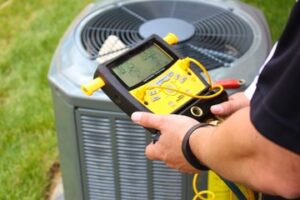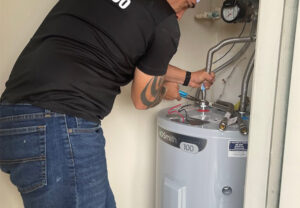The HVAC industry is constantly changing, and innovations are emerging. These include intelligent systems that connect to the internet and green technologies that reduce carbon footprints.

The first thing you should know about HVAC is that it moves air throughout your home to adjust the temperature. It also carries air through ducts and removes excess humidity from the air. Visit https://promastersheatingandair.com/ to learn more.
An HVAC system is the equipment used to regulate temperatures, air quality and humidity in homes and commercial or industrial spaces. It also may be responsible for ventilating these spaces to dilute harmful chemicals and odors from occupants, volatile organic compounds from interior furnishings and other sources. The equipment performs all of these functions by using a combination of heating, ventilation and air conditioning units as well as ductwork and thermostats.
A basic HVAC system consists of a furnace, air conditioner or heat pump, evaporator coil and blower fan. Its primary function is to create a comfortable indoor environment by heating and cooling the air in accordance with human comfort and health requirements. The system is powered by either natural gas or electricity and may use a variety of fuel sources, including solar energy.
The HVAC system’s air intake point is located at the top of your ductwork, which it uses to draw in fresh, clean air. The air passes through an air filter to remove any contaminants and is then funneled into the main part of the system. The blower in the air handler is then used to circulate the conditioned, cleaned air throughout your home or space.
While most residential and commercial HVAC systems are forced-air, a ductless mini-split system can be utilized for certain needs or applications. These unique systems are more expensive initially, but allow occupants to control the climate in their own space rather than having to share a central unit.
AFUE-Measures the furnace’s efficiency in converting fuel to heat energy. A higher AFUE means greater efficiency and lower fuel costs.
SEER-Measures air conditioner or heat pump efficiency, and a higher SEER rating is more efficient. HSPF-Measures the heating efficiency of a heat pump, and an HSPF of 7.8 or more is considered high.
A packaged system contains all of the components of the heating and cooling in one self-contained unit, which makes it easier to maintain. This type of system is often installed on rooftops to save space and can be especially beneficial for larger homes in warmer climates.
Ventilation
Ventilation is the part of an HVAC system that brings in fresh air, reduces humidity levels and ensures a uniform temperature in different areas of a home or office. It includes the air handler, ducts and return vents as well as the blower assembly. Without proper ventilation a home or office would not be comfortable to live in because bad air wouldn’t get out and good air wouldn’t come in.
A good ventilation system should have an air filter, which should be changed regularly to keep the system clean. This will help to reduce the number of contaminants in the air such as dust, pollen, pet dander and chemicals from cleaning products. It also helps to reduce static pressure loss in the system and saves energy by lowering the amount of power needed to operate the fans.
Another component of a ventilation system is an exhaust fan which removes gases and moisture from the building. This helps to reduce the risk of mold, mildew and other problems and is particularly important for indoor pools. Ventilation systems can also include a carbon monoxide detector, which will alert occupants to the presence of CO and other toxic fumes.
Highly efficient ventilation systems use less energy to operate than conventional ones, which contributes to reduced electricity bills and helps with environmental concerns like climate change. They can reduce energy consumption by up to 40%. These systems require specialized design and engineering during the construction phase to achieve their full potential. They are most effective in buildings with good insulation, airtight envelopes and efficient heating and cooling systems.
Air conditioning is an essential part of a good ventilation system and can be provided by central air conditioners, window ACs or ductless mini-split systems. Air conditioning helps to improve comfort levels during the hotter months and is important for maintaining thermal comfort in buildings.
Cooling
An HVAC system includes heating and cooling units to control temperature, humidity, air purity, and ventilation in homes, schools, hospitals, and commercial and industrial buildings. Its design is a subdiscipline of mechanical engineering, based on principles of thermodynamics, fluid mechanics, and heat transfer. The term “HVAC” is most commonly used to refer to a climate control system that combines heating, ventilating, and air conditioning.
Ventilation is a key element of all HVAC systems, and it may take place naturally or using mechanical means like fans and ducts. This process draws outside air into a building through open windows, doors, and cracks, and it brings in fresh air from the outside. Then it distributes that air throughout the building through a network of ducts.
The most familiar component of an HVAC system is the air conditioner, which cools indoor air during warmer periods. It removes heat from the air by using a cycle that involves the evaporator coil, compressor, and condenser. The refrigerant in the system changes from a liquid to a gas and back again as it goes through this process, and it’s this transformation that lowers the indoor air temperature.
HVAC systems can be configured in different ways to suit the needs of each building. Some use a central air conditioning unit with ductwork that distributes conditioned air to rooms through a series of vents and registers. These systems are most common in homes and large office buildings. Others use ductless mini-split systems that exchange cooled air directly with living spaces and don’t require any ductwork.
When choosing an HVAC contractor, look for one with NATE certification. This indicates that the technician has passed rigorous exams to prove his or her knowledge of HVAC technology. In addition, it’s important to find a technician who is licensed and insured.
In between maintenance visits, you can keep your HVAC system running at peak performance by replacing the air filter regularly. This will help prevent the airflow from becoming clogged with debris, which can lead to insufficient cooling and higher energy bills. It’s also a good idea to trim any plants and other debris that might get in the way of the outdoor AC or heat pump. This will improve airflow and help the equipment last longer.
Maintenance
Just like your car needs regular oil changes, so does your HVAC system. Without routine maintenance, your HVAC unit can start to show wear and tear, which may result in costly repairs. Oftentimes, you can avoid these repair bills by scheduling an inspection and having your HVAC technician perform minor services.
The two most basic forms of HVAC maintenance are regularly scheduled filter changes, as well as evaporator and condenser coil cleaning. By keeping these items clean, your HVAC unit can operate efficiently and your occupants will benefit from cleaner indoor air. In addition, your HVAC technician can check for and replace belts that have begun to crack or break. If left unattended, these issues can lead to your system’s safety limits tripping, which could shut down the system or cause other problems with your equipment.
Routine HVAC maintenance also prolongs the life of your system. An average system can function for close to 15 years if properly maintained. By catching small issues during routine inspections, you can extend the lifespan of your current system and put off the cost of replacing it.
When your HVAC system isn’t well-maintained, it loses 5% of its efficiency each year. That’s a lot of money that you’re losing out on, not to mention the wasted energy that it produces. The best way to save on energy costs is by having your HVAC system inspected and serviced each year.
During these maintenance visits, your technician will inspect and test all of the components. They’ll also thoroughly clean both the interior and exterior units, which allows your system to operate at its maximum efficiency. In addition, they’ll clean the air ducts, clip any grass or shrubbery around the outside unit and clear debris from the inside vents. This will help prevent dust and mold from building up in your home, improving indoor air quality for your occupants. Moreover, a professional will clean the air filters and evaporator coils to prevent the build-up of dust, allergens and bacteria that can trigger respiratory illnesses. They’ll even disinfect and deodorize the system to remove any unpleasant odors from your space.

